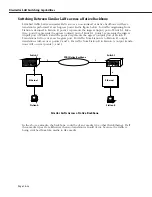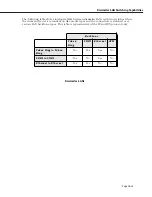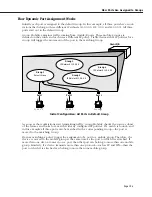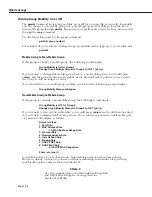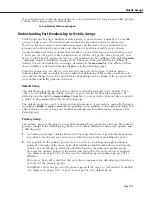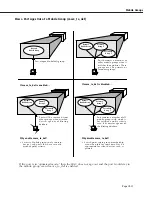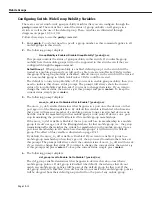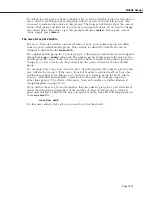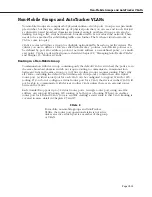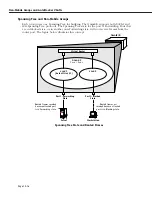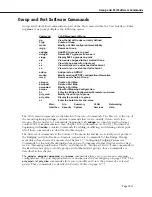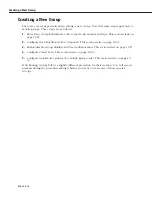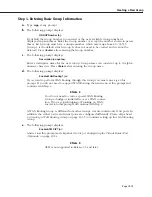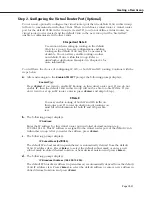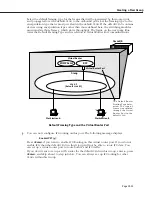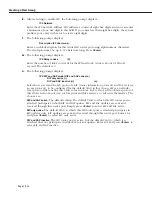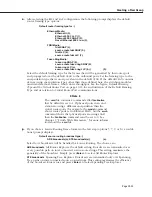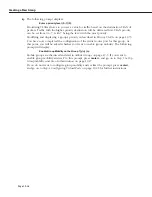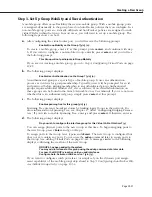
Mobile Groups
Page 19-12
Configuring Switch-Wide Group Mobility Variables
There are several switch-wide group mobility variables that you can configure through the
gmcfg
command. These variables control the status of group mobility on all groups in a
switch as well as the use of the default group. These variables are illustrated through
diagrams on pages 19-9 to 19-11.
Follow these steps to use the
gmcfg
command:
1.
Enter
gmcfg
. You do not need to specify a group number as this command applies to all
mobile groups in this switch.
2.
The following prompt displays:
Group Mobility is Enabled. Disable Group Mobility ? [yes/no] (no) :
This prompt controls the status of group mobility in this switch. If you disable group
mobility here then mobile groups will not be supported in this switch even if they are
configured through the
crgp
command.
Default Group 1
. When group mobility is enabled, default group 1 in the switch will be
treated as a mobile group and you will not be able to create AutoTracker VLANs within
this group. When group mobility is disabled, default Group 1 in the switch will be treated
as a non-mobile group in which AutoTracker VLANs could be created.
The default is to turn Group Mobility off. If you want to enable group mobility, then you
need to indicate that choice at this prompt. The prompt will always show the current
status of Group Mobility and then ask if you want to change that status. If you want to
change the current status, then enter a
y
at this prompt and press
<enter>
. To keep the
current status, simply press
<enter>
.
3.
The following prompt displays:
move_to_def is set to Disabled. Set to Enable ? [yes/no] (no) :
The move_to_def variable determines what happens to a port once the devices on that
port age out of the filtering database. By default this variable is Disabled, which means
that a port will remain a member of a mobile group as long as its attached device satis-
fied the criteria for membership in that mobile group at one point. If devices on a port
stop transmitting, the port will still retain all its mobile group memberships.
If the move_to_def variable is Enabled, then a port will lose its membership in a mobile
group if its devices age out of the filtering database for that mobile group (i.e., they stop
transmitting traffic that satisfies the criteria for membership in the mobile group). Once a
port loses membership in all criteria-based mobile groups, it will return to its default
group. The effect of this variable is illustrated on page 19-11.
By default, the move_to_def variable is Disabled. If you want to enable it (ports lose
mobile group membership when they age out), then you need to indicate that choice at
this prompt. The prompt will always show the current status of move_to_def and then ask
if you want to change that status. If you want to change the current status, then enter a
y
at this prompt and press
<enter>
. To keep the current status, simply press
<enter>
.
4.
The following prompt displays:
def_group is set to Enable. Set to Disable ? [yes/no] (no) :
The def_group variable determines what happens to devices that do not match any
mobile group policies. If def_group is Enabled (the default), then devices that do not
match any mobile group policies will be part of the default group for that port. If the
def_group variable is Disabled, then devices that do not match any mobile group policies
will be dropped from their default group and will not be part of any mobile group.
Summary of Contents for Omni Switch/Router
Page 1: ...Part No 060166 10 Rev C March 2005 Omni Switch Router User Manual Release 4 5 www alcatel com ...
Page 4: ...page iv ...
Page 110: ...WAN Modules Page 3 40 ...
Page 156: ...UI Table Filtering Using Search and Filter Commands Page 4 46 ...
Page 164: ...Using ZMODEM Page 5 8 ...
Page 186: ...Displaying and Setting the Swap State Page 6 22 ...
Page 202: ...Creating a New File System Page 7 16 ...
Page 270: ...Displaying Secure Access Entries in the MPM Log Page 10 14 ...
Page 430: ...OmniChannel Page 15 16 ...
Page 496: ...Configuring Source Route to Transparent Bridging Page 17 48 ...
Page 542: ...Dissimilar LAN Switching Capabilities Page 18 46 ...
Page 646: ...Application Example DHCP Policies Page 20 30 ...
Page 660: ...GMAP Page 21 14 ...
Page 710: ...Viewing the Virtual Interface of Multicast VLANs Page 23 16 ...
Page 722: ...Application Example 5 Page 24 12 ...
Page 788: ...Viewing UDP Relay Statistics Page 26 24 ...
Page 872: ...The WAN Port Software Menu Page 28 46 ...
Page 960: ...Deleting a PPP Entity Page 30 22 ...
Page 978: ...Displaying Link Status Page 31 18 ...
Page 988: ...Displaying ISDN Configuration Entry Status Page 32 10 ...
Page 1024: ...Backup Services Commands Page 34 14 ...
Page 1062: ...Diagnostic Test Cable Schematics Page 36 24 ...
Page 1072: ...Configuring a Switch with an MPX Page A 10 ...
Page 1086: ...Page B 14 ...
Page 1100: ...Page I 14 Index ...

